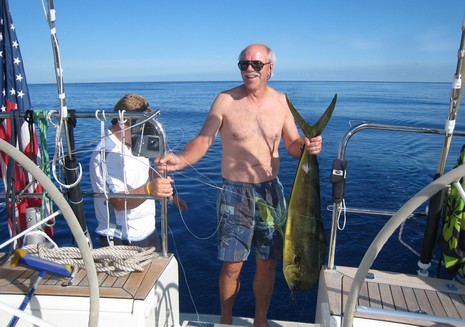Panbo offshore, 3rd try

6/28 I’m now ashore and able to upload this shot of Malcom Willard showing off a three-meal dolphin on a lake-like Atlantic ocean. It was taken on Tuesday, a few hundred miles south of the Gulf Stream. I didn’t manage to get the text below online until Wed. afternoon. Note that no electronics played a part in the fish’s demise:
Note to self: If I ever get to try this again—posting a Panbo entry from offshore with a sat phone—
the trick would be to have an intermediary who I could e-mail content to. XGate (OCEN’s) email is quite easy and fast, and therefore (relatively) inexpensive. Actually going to the Panbo Web site to post an entry is another matter. I’m using XWeb, which optimizes the process, but there’s no getting around the fact that Iridium data moves at a base rate of 2,400.
As Luis Soltero, the genius developer behind Global Marine Networks, says, “Xweb accelerates browsing on average from 3 to 5x. This means that over iridium you browse at a whopping 7200 to 12000 baud at $1.50 per minute… So no matter what iridium is not your best platform for browsing. Having said that if you have to browse then its better to do it with xweb than with nothing!”
Globalstar’s base rate, of course, is 4x faster, and is probably pretty usable with XWeb but Bill is reluctant to go online since the XGate products are running on his navigation computer. Plus, due to Globalstar’s spotty connection rate, surfing might be frustrating (I don’t think the new birds are operational yet, so that might change at any moment). XGate e-mail, though, has made downloading GRIB files much easier on Visions of Johanna, and I’m extremely impressed with how they can be used with Expedition charting/routing software (misnamed Explorer in an earlier post).
At any rate, getting select email, being able to download all sorts of weather files, and being able to place a phone call any time is pretty darn offshore-connected for this old geek. Browsing can wait. Life aboard is fine. Bill and Gram know this boat inside out and run it well. We’ve been mostly motor sailing but the engine is very well sound insulated. Yesterday we stopped and swam in the deeps south of the Gulf Stream, and later caught a 40″ dolphin fish, which became dinner fillets, then breakfast fish cakes, and will make its last appearance later today as seviche. The Nauticast B is working great, seen by several vessels at about 10nm despite 10′ antenna height. None have been able to decipher our static info (name, size, type), though, an expected problem but more pervasive than I’d hoped. On the other hand, it’s been easy to call every ship seen, mainly because we knew their name, and they knew our MMSI. More later, though maybe not until we arrive Rockland, ME, on Thursday.













Your post brought to mind a product called Contact from a company called Human Edge Tech at http://www.humanedgetech.com. They have a package they
developed for expeditions to allow direct posts to websites from remote locations like Everest or your location using a sat phone and a PDA. Its a
pretty cool technology/concept but a bit pricey. Might be an interesting product for you to look at sometime.
Tell us more about illegible static data!